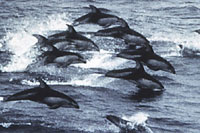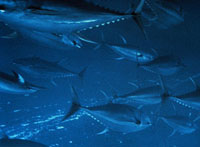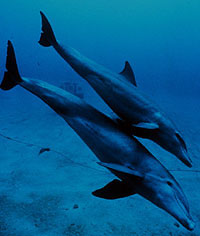There were predictable cries of protest from some conservationists who focus on charismatic megafauna when revised standards for use of the “dolphin safe” tuna label were announced by the Commerce Department in April. Though the new rules stipulate that no dolphins should be killed or seriously injured, they do let canners label their product “dolphin safe” even if tuna are caught using large, encircling nets that can snare dolphins.

Charismatic megafauna at play.
Photo: NOAA.
The environmental community is split on the revised rules. Greenpeace and the Center for Marine Conservation, among other organizations, say the changes are needed to get the international fishing community on board with stronger dolphin protections. A separate coalition of groups, including Defenders of Wildlife and the Earth Island Institute, filed suit against the Commerce Department in August, seeking to overturn the new rules.
Yet another side of the story is that protection of dolphins in the Eastern Tropical Pacific Ocean under the old “dolphin safe” rules resulted in the slaughter of millions upon millions of pounds of unwanted marlin, wahoo, sharks, and other species of pelagic fish, as well as the sustained harvest of immature, not-yet-spawned tuna. Our rush to “save the dolphin” may well have created devastating environmental impacts, which are still largely unrecognized.
Screening Bloody Murder
It all began in the late 1980s, when graphic videos of dolphins being drowned in Panamanian tuna purse seine nets were aired on international television. Thousands of porpoises were being rounded up, along with the schools of tuna sought by the seiners, and many of the air-breathing mammals were drowned as nets were “pursed,” smothering the animals in a mass of fish and net mesh. It was a nightmarish scene, one that pulled at the heartstrings of all but the most stoic.
Schools of mature yellowfin tuna in the Eastern Tropical Pacific are often found swimming beneath dolphins, and tuna seiners were using surface dolphin activity as a guide to set their nets, trapping many dolphins as a result.

Yellowfin tuna, uncanned.
Photo: NOAA.
The American tuna industry had begun making efforts on its own to curb the thousands of dolphin deaths, by improving its equipment, developing specialized maneuvering and recovery techniques, and physically helping dolphins escape from nets.
Still, the graphic videotape of drowning dolphins led to one of the most effective fund-raising and lobbying efforts in the recent history of environmental activism. The pressure was on to stop the killing of any dolphin, leading to the ultimately successful campaign to make every can of tuna in the U.S. “dolphin safe.”
Sorry, Charlie
After the outcry over dolphin deaths, tuna seiners who had worked in the Eastern Tropical Pacific crossed the ocean to new grounds and began using a different technique called log fishing. The seiners set their nets on various floating objects (generally referred to as “logs,” although any floating objects serve the purpose, including those set out by seiners themselves). Tuna congregate under the logs, as do many other species. But this shift of location and technique seems to have been bad news for tuna populations.
In the Eastern Tropical Pacific, the tuna catch had primarily consisted of mature adults which would presumably have spawned several times before they were harvested. The encirclement method used in this region also produced very little by-catch, according to David Itano, a fishery biologist with the University of Hawaii’s Pelagic Fisheries Research Program.

The shark — a casualty of casserole?
But under the “dolphin safe” rules developed in the early 1990s, a typical haul of 1,000 tons of tuna caught primarily by the log method results in the killing and dumping of 200 to 400 tons of small, immature yellowfin and skipjack tuna, according to fisheries biologist Bill Boyce, a former tuna purse seine fishery observer for the National Marine Fisheries Service. “These fish haven’t even spawned yet!” he says.
Also, log fishing, because of the diverse community associated with the floating object, has the highest by-catch levels of any seining method, reports Itano. “Generally, 1,500 sharks, 2,000 to 5,000 dorado, 2,000 to 3,000 wahoo, 50 to 100 marlin, 200 to 300 sailfish, plus rainbow runners, triggerfish, small jacks, and tripletail are dumped, dead, on every trip these boats now make,” says Boyce.
So the tuna fishery was transformed from one that might have resulted in the deaths of 10 to 30 dolphins for a 1,000-ton load of mature yellowfin tuna to one that may be far more destructive ecologically. An issue that had seemed straightforward to many activists — we should stop killing dolphins, of course — turned out to be far more complex.
What’s Eating You?
Sadly, we do not have adequate biological knowledge to quantify the full extent of the destruction, but it is clear that the capture of millions of tuna too young to have spawned and the killing of many other species that are critical to the pelagic ecosystem cannot be good for the Pacific’s environment over the long run.

Dolphins in the deep blue sea.
Photo: OAR/NURP.
One approach to the problem might be to convene a single, Pacific-wide, pelagic fishery management authority, and to support widespread biological investigations into the impact of tuna fishing in the Pacific. Currently there are various meetings of scientists with political overtones, and there are separate political meetings of governments with scientific input. Interest in broader regional management seems to be mounting, but it could take a while to come together because of the varying concerns of individual governments and the difficulty of meshing large organizations with other players.
Ocean ranching — in which fish are produced in hatcheries, released to feed at sea, and later harvested — could also help supply tuna to a demanding market.
In any case, it seems clear that simply barring the slaughter of Eastern Tropical Pacific dolphins is not the best alternative for the environment.
Perhaps the simplest remedy would be to eat less tuna.


